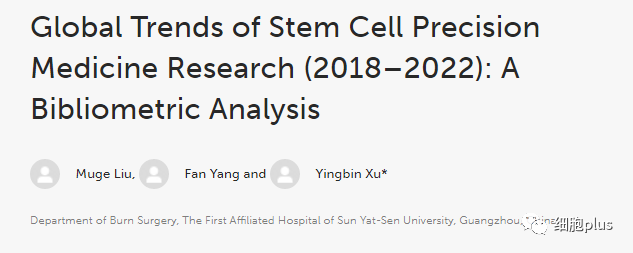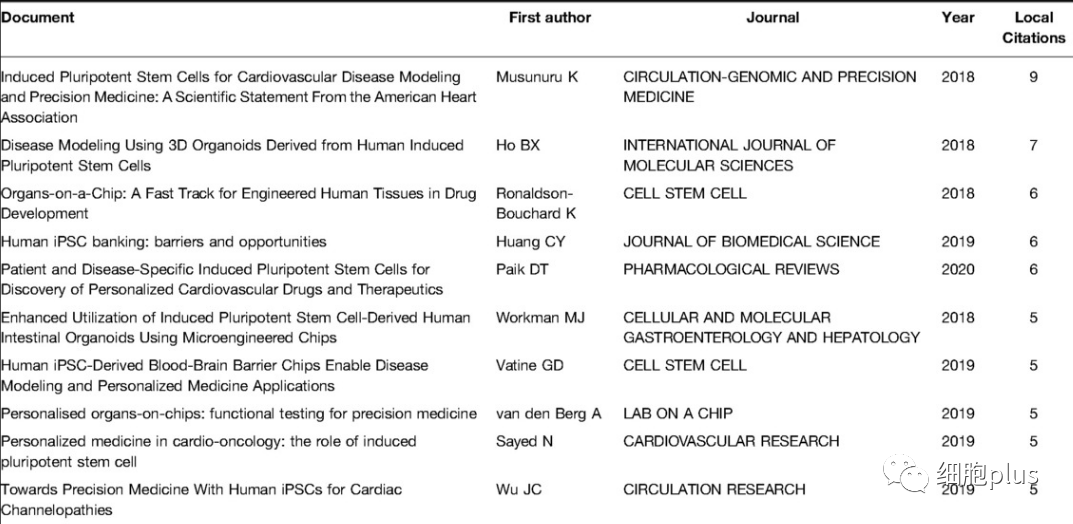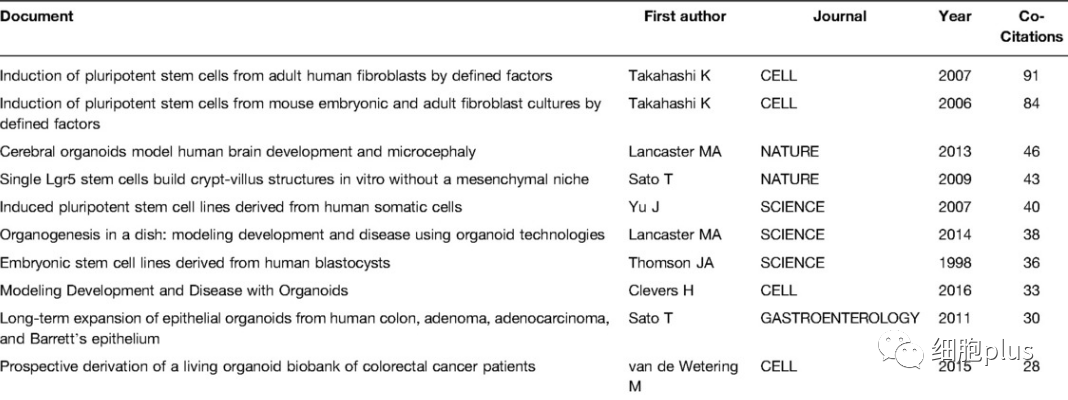Global Trends in Stem Cell Precision Medicine Research (2018–2022)
Xu Yingbin etc. from the Department of Burn Surgery of the First Affiliated Hospital of Sun Yat-sen University and others recently published a paper in Frontiers, analyzing the global trend of stem cell precision medicine research (2018-2022) through bibliometrics.
Replacing the body's dysfunctional tissue with stem cells has been studied since 1963, when it was reported that bone marrow cells rescued an animal from lethal radiation. Embryonic stem cells and IPSCs have been used in clinical studies of various diseases. In addition to self-renewal and differentiation, stem cells also regulate the activities of surrounding cells through paracrine factors. However, due to the high variability of stem cell populations, the regulatory mechanisms have not been elucidated. Another strategy for stem cell therapy is to activate the proliferative and differentiation potential of somatic stem cells, such as altering the activity of erythropoietin progenitors. Stem cells can build specific disease models and are promising in disease research and new drug development. These disease models include tumors, cardiovascular diseases and neurological diseases, and these disease models are mainly completed by induced pluripotent stem cells.
Precision medicine is an emerging medical model that provides individualized medical diagnosis, treatment, and care for a specific patient after taking into account their genetic information, physiological/pathological information, living environment, and many other aspects. Compared with the traditional one-size-fits-all approach, more emphasis is placed on the impact of individual differences on disease development. The research on stem cell precision medicine has made great progress in recent years. Stem cell technology, especially induced pluripotent stem cell technology, has gradually matured. Researchers can build disease/patient-specific models to accurately reflect individual differences in human disease mechanisms and drug responses based on pluripotent and regenerative human stem cells.
The realization of precision medicine is an inherent advantage that cannot be obtained by traditional disease models. Disease models have been established using induced pluripotent stem cells via (CRISPR)/CRISPR-associated system (CRISPR-Cas9) genome engineering tools, including cardiomyopathy, valvular disease, primary microencephaloma, cystic liver fibrosis, colorectal cancer Wait. However, stem cell-based disease models are still in the early stages of development. 3D organoid models can accurately simulate organ morphology, form tissue-like structures, and realize organ/disease development in in vitro organ culture systems. More complex 3D organoid multisystem models are still in development, including adding circulatory and lymphatic systems.

The authors searched 552 articles between 2018 and 2022. Annual publication production is on an upward trend and peaks at 172 in 2021 (see chart below).
The United States contributed the most to publications in this field (160, 29.0%), followed by China (63, 11.4%) and Italy (60, 10.9%). (See below)
It can be seen that North America, Asia and Europe are the central regions of scientific research and production.
The United States undoubtedly dominates the field of stem cell precision medicine research, contributing approximately 30% of existing publications. Seven of the top 10 donors are from the United States, including Stanford University, Harvard Medical School, Icahn School of Medicine at Mount Sinai, University of Pennsylvania, University of Illinois at Chicago, University of Pittsburgh and University of Washington. Notably, the U.S. has active inter-country collaborations, but the MCP ratio is relatively low, suggesting that stem cell precision medicine research in the U.S. is more independent and advanced than in other countries.
It is worth noting that China surpassed European countries in the publication of stem cell precision medicine, ranking in the top three. Most of the high-yield institutions are from the US, with only three from Australia, Canada and Italy. This information shows that China is an Asian country with high research output but relatively scattered research units. These differences may be attributed to the government's emphasis on scientific research, the availability of adequate funding, and the rapid development of research capacity in recent years.

CANCERS was the most prolific journal with 18 articles, NATURE was the most cited journal with 1860 citations, followed by CELL and Cell Stem Cell with 1241 citations respectively and 1218 times. In citation reports, the top 3 journals are all in Q1, while the top 10 have the highest impact factor of 91.253 (2020), and Scientific Reports ranks in the top 10 both in terms of output and co-citations. In the past five years, no papers on stem cell precision medicine have been published in top journals, but overall journals are still distributed in the Q1 region. Overall, the research quality of stem cell precision medicine is quite high.
The highest-cited paper produced in five years is "Induced Pluripotent Stem Cells for Cardiovascular Disease Modeling and Precision Medicine: A Scientific Statement From the American Heart Association. scientific statement)”, cited 9 times. In this study, the authors show that there are currently two ways to model cardiovascular disease using induced pluripotent stem cells: iPSCs from patient-specific cells such as skin fibroblasts or gene editing. Cardiovascular disease models based on iPSCs cover cardiomyopathy, arrhythmias, valvular and vascular diseases, ischemic heart disease, familial pulmonary hypertension, and more. However, there are still relatively intuitive differences between cardiomyocytes differentiated from iPSCs and adult cardiomyocytes, which are reflected in cell shape, electrophysiology, calcium handling, mitochondrial physiology, and response to epinephrine signaling. In precision medicine, cardiovascular organoids constructed from induced stem cells play a role in screening patients for DNA mutations, disease development mechanisms, and treatments for specific diseases. In the future, we look forward to the large-scale production of induced pluripotent stem cells and the construction of stem cell banks for important directions such as drug toxicity tests.
The second most cited article is "Disease Modeling Using 3D Organoids Derived from Human Induced Pluripotent Stem Cells". Compared with 2D models, 3D organoids derived from induced pluripotent stem cells can highly mimic the natural physiological environment. It has advantages in constructing vascularization models and studying complex inflammation models. The authors summarize the organ-like disease models constructed by human induced pluripotent stem cells, including brain, liver, pancreas, small intestine, stomach, kidney, bladder, lung, retina, etc. However, there are still drawbacks in 3D-like organoids. The modeling technology of three-dimensional organoids of induced pluripotent stem cells is complex and requires high technical requirements. Furthermore, cells (endothelial cells, monocytes, macrophages, etc.) and cellular physiological changes (leukocyte migration, monocyte differentiation, etc.) are constructed based on vascularization. Vascularization in the model is not yet complete and an extensive vascular network cannot be constructed at this stage. Nonetheless, human induced pluripotent stem cells still play an important role in disease modeling and drug screening.
The third most cited article is "Organs-on-a-Chip: A Fast Track for Engineered Human Tissues in Drug Development" describing an Organ-on-a-Chip key role in drug development. Human induced pluripotent stem cells are involved in the development of organ-on-a-chip structures. Methods for the construction of individual organoid chips include primary cells, cell lines, iPSCs, MSCs, and other cells. Multiple Organ Chips can be perfused, recirculated, and recirculated with tissue-specific media via static, single-circuit.
The fourth highly cited paper is "Human iPSC banking: barriers and opportunities" in 2019, which focuses on summarizing the development status of iPSC banks, and introduces the cell sources of iPSC banks worldwide, Reprogramming methods, characterization methods, operations.

The top three most cited historical documents in five years were: "Induction of pluripotent stem cells from adult human fibroblasts by defined factors" (n = 91)
"Induction of pluripotent stem cells from mouse embryonic and adult fibroblast cultures by defined factors" (n = 84)
"Cerebral organoids model human brain development and microcephaly" (n = 46).

Through CiteSpace, an explosive analysis of reference citations was performed, and five references were selected here.
The document below shows the highest burst intensity (4.09) for "Organogenesis in a dish: modeling development and disease using organoid technologies".
Followed by "Microfluidic organs-on-chips" (2.8),
The third is "Organoid cultures derived from patients with advanced prostate cancer" (2.03).
The content of the first three citing surge cited papers focused on the current and future uses of induced pluripotent stem cells, which shows that the application prospects in disease modeling, drug testing and even organ replacement are promising by researchers.